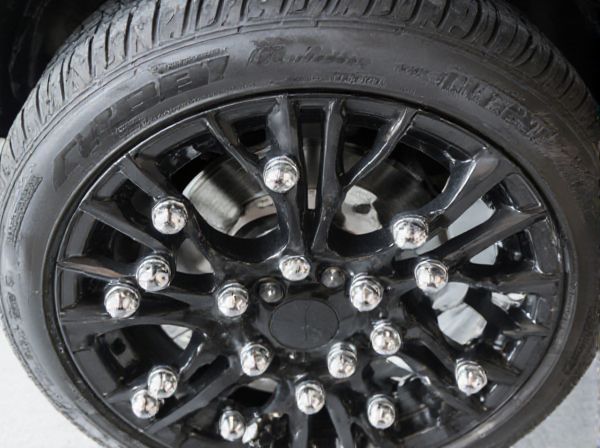
Photo illustration: Studded vs Studless
Studded tires provide superior traction on icy and snowy roads due to metal studs embedded in the tread, making them ideal for extreme winter conditions. Studless tires rely on advanced rubber compounds and tread patterns to maintain grip on slippery surfaces while offering a quieter and more comfortable ride. Choosing between studded and studless tires depends on Your typical winter driving conditions and local regulations.
Table of Comparison
| Feature | Studded Tires | Studless Tires |
|---|---|---|
| Traction on Ice | Excellent due to metal studs | Good but less effective than studded |
| Traction on Snow | Very good | Good to very good with advanced rubber compounds |
| Road Noise | High due to studs | Low and quieter ride |
| Road Wear | Increases road surface damage | Minimal road wear |
| Legal Restrictions | Regulated or banned in some areas | Generally allowed everywhere |
| Price | Typically higher due to studs | Moderate price |
| Lifespan | Shorter if used on dry roads | Longer with proper use |
Introduction to Winter Tires: Studded vs Studless
Winter tires play a crucial role in enhancing vehicle safety and performance during icy and snowy conditions. Studded winter tires feature metal studs embedded in the tread to provide superior traction on ice, while studless tires rely on advanced rubber compounds and tread designs to maintain grip on snow and slush. Choosing between studded and studless tires depends on driving conditions, legal regulations, and the balance between ice traction and road noise.
Key Differences Between Studded and Studless Tires
Studded tires feature metal studs embedded in the tread to enhance traction on icy and packed snow surfaces, providing superior grip in extreme winter conditions. Studless tires rely on advanced rubber compounds and tread designs, such as siping and deep grooves, to maintain flexibility and channel water, improving performance on snow and slush without damaging road surfaces. The key differences lie in traction effectiveness on ice, road noise, and surface wear, with studded tires excelling in ice grip but causing increased road wear and noise compared to quieter, more versatile studless tires.
Performance on Ice: Studded Tire Advantages
Studded tires provide superior traction on icy surfaces due to metal studs embedded in the tread, which bite into ice for enhanced grip and reduced slipping. Their design offers improved braking performance and cornering stability on hard-packed snow and black ice conditions. This makes studded tires particularly advantageous for drivers frequently encountering extreme winter weather and hazardous road surfaces.
Performance on Snow: Studless Tire Benefits
Studless tires excel on snow by providing excellent traction through advanced siping technology that creates numerous biting edges, enhancing grip on icy and packed snow surfaces. These tires offer a quieter and smoother ride compared to studded tires, reducing road noise and vibrations while maintaining consistent performance in fluctuating winter conditions. The absence of metal studs reduces road wear and environmental impact, making studless tires a popular choice for eco-conscious drivers seeking reliable snow performance.
Road Noise and Comfort Comparison
Studless tires are designed with softer rubber compounds and specially engineered tread patterns that significantly reduce road noise and enhance ride comfort compared to studded tires. Studded tires, equipped with metal studs for improved traction on ice, tend to generate higher noise levels and transmit more vibrations to the vehicle cabin, leading to a less comfortable driving experience on dry or wet pavement. For drivers prioritizing a quiet and smooth ride, studless tires offer superior comfort by minimizing road noise without compromising winter traction on snow and ice.
Tread Life and Durability Considerations
Studded tires offer enhanced traction on icy surfaces but tend to wear out faster on dry pavement due to metal studs damaging the tread, resulting in shorter tread life. Studless tires utilize advanced rubber compounds and tread designs to maintain flexibility and grip in cold conditions, providing longer durability and more consistent tread wear across varied winter road conditions. Choosing between studded and studless tires depends on balancing maximum ice traction with the desired tread lifespan and overall tire durability in typical driving environments.
Legal Restrictions on Studded Tires
Legal restrictions on studded tires vary significantly by country and region, with many areas enforcing seasonal bans or outright prohibitions due to road damage concerns. In the United States, states like California and New York impose specific timeframes when studded tires are permitted, often allowing use only during winter months. European nations such as Germany and the United Kingdom generally restrict or ban studded tires on public roads, emphasizing the need to check local regulations before installation.
Environmental Impact: Studded vs Studless
Studded tires generate more road wear and release particulate matter, contributing to increased environmental pollution and infrastructure damage. Studless tires reduce surface abrasion, lowering the amount of dust and debris released into the air, thereby lessening their ecological footprint. Choosing studless tires supports sustainable road maintenance and improved air quality, aligning with environmental conservation goals.
Cost Comparison and Value Over Time
Studless tires typically have a higher initial cost compared to studded tires due to advanced rubber compounds and specialized tread designs. Over time, studless tires often provide greater value by offering extended tread life and consistent performance on dry and wet surfaces without damaging road infrastructure. The longevity and reduced maintenance costs of studless tires can result in overall savings despite their upfront price difference.
Choosing the Best Option for Your Winter Driving Needs
Studded tires provide superior traction on icy roads by embedding metal studs that grip the surface, ideal for regions with frequent ice coverage. Studless tires use advanced rubber compounds and tread designs to enhance grip on snow and slush, offering quieter rides and better performance on dry pavement. Selecting the best option depends on local winter conditions, with studded tires favored for aggressive ice, while studless models suit areas with mixed road surfaces and variable temperatures.
 caratoz.com
caratoz.com